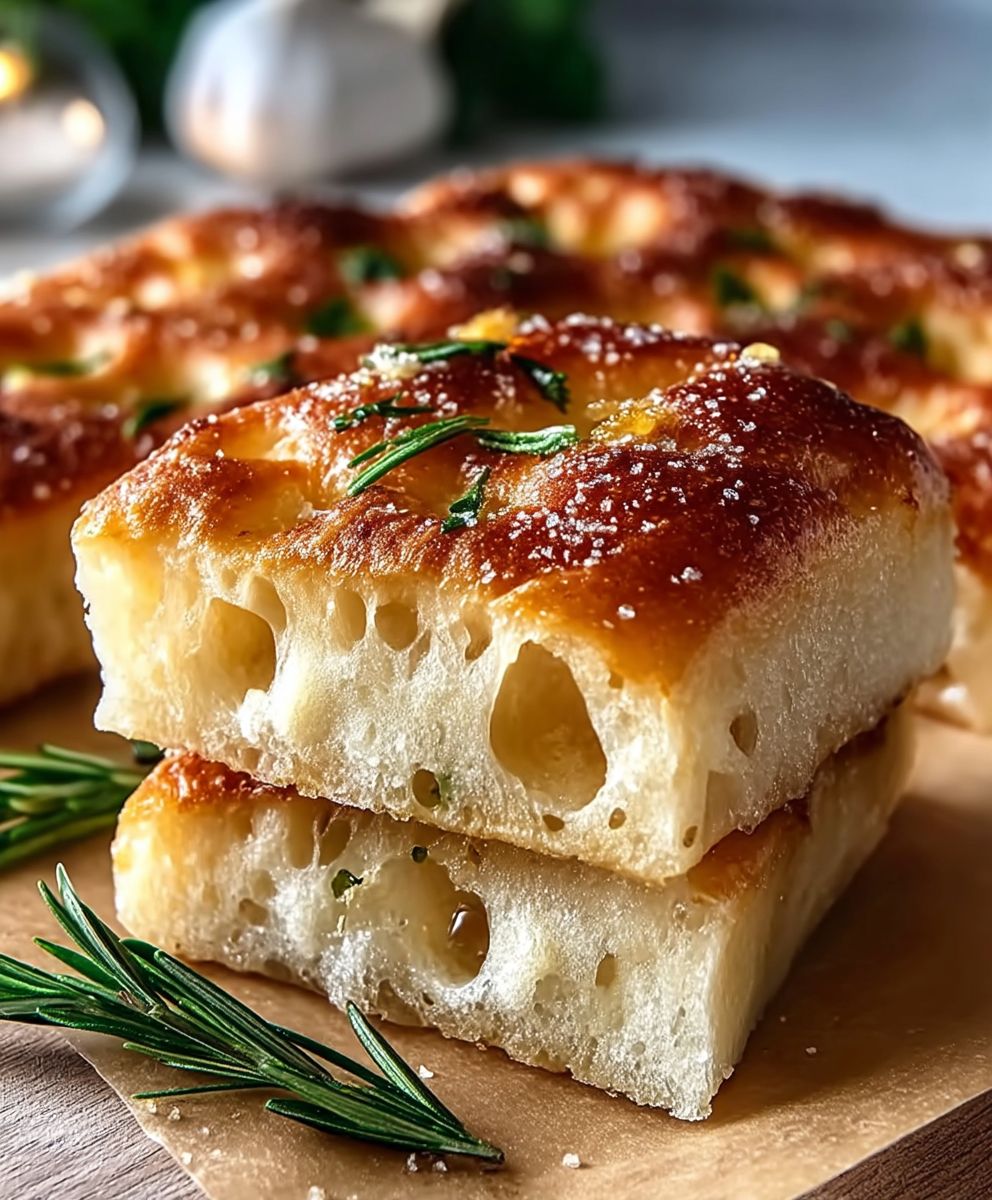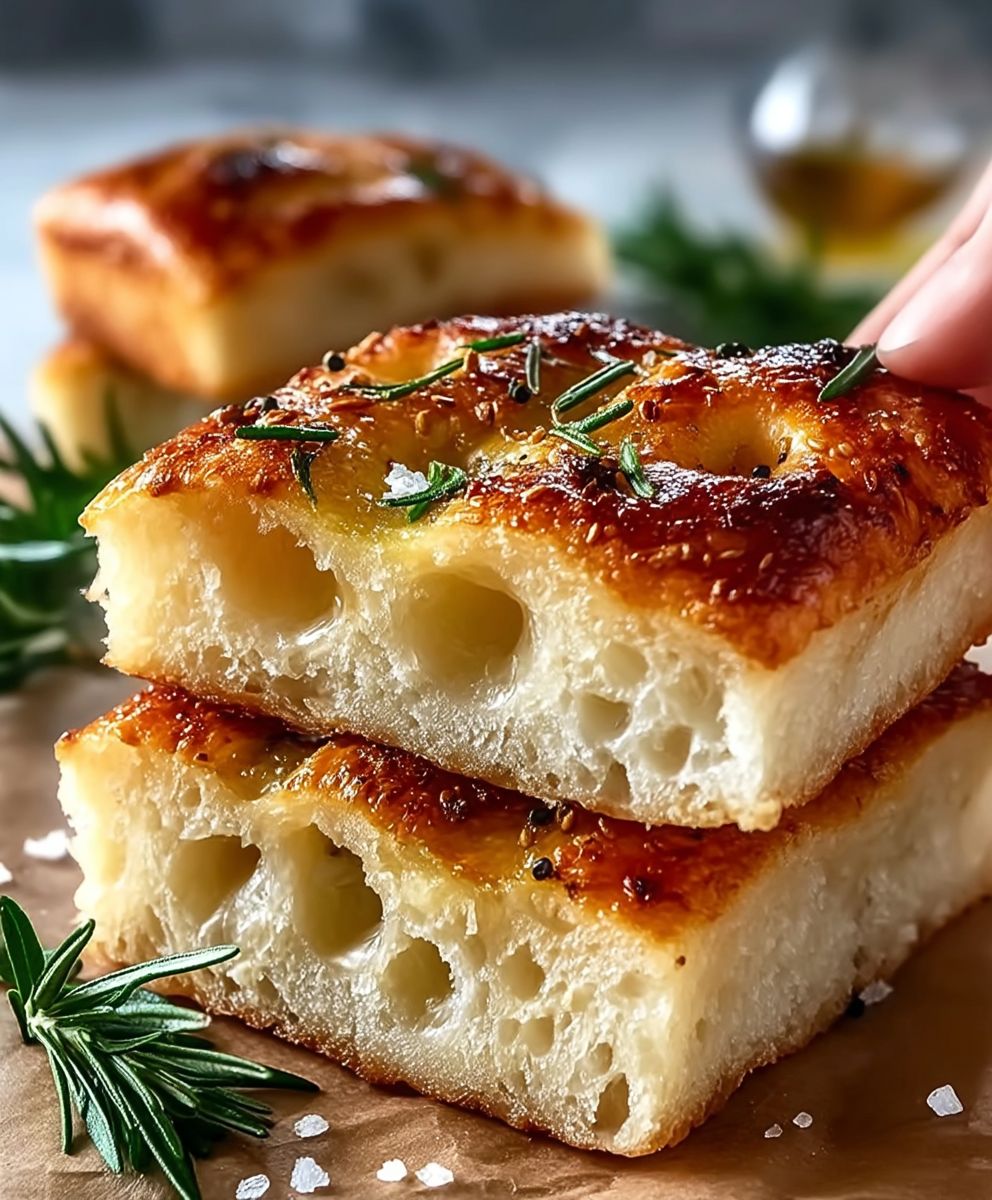Rosemary Focaccia, a simple yet utterly captivating Italian bread, is about to become your new favorite baking project. Imagine sinking your teeth into a golden-brown crust, yielding to a soft, airy interior infused with the fragrant aroma of fresh rosemary and the subtle tang of olive oil. Are you drooling yet? I know I am just thinking about it!
Focaccia’s history stretches back to ancient times, with roots in the Etruscan civilization long before the Roman Empire. It was originally baked on the hearth and served as a staple food, a blank canvas for various toppings and flavors. Over centuries, regional variations emerged, each reflecting the local ingredients and culinary traditions. The version we’re making today, Rosemary Focaccia, is a classic for a reason.
What makes focaccia so beloved? It’s the perfect combination of simplicity and indulgence. The dough requires minimal ingredients, yet the baking process transforms it into something truly special. People adore its versatility it’s fantastic on its own, dipped in olive oil, or used as a base for sandwiches and pizzas. The satisfying chewiness, the delightful saltiness, and the herbaceous notes of rosemary create a symphony of flavors and textures that will leave you wanting more. Plus, the active time is minimal, making it a great recipe for beginner bakers or those looking for a relatively quick and easy bread to make.
Ingredients:
- 600g strong bread flour, plus extra for dusting
- 500ml warm water (around 105-115°F or 40-46°C)
- 7g (2 ¼ teaspoons) active dry yeast
- 15g fine sea salt
- 60ml extra virgin olive oil, plus extra for greasing and drizzling
- 2 sprigs fresh rosemary, leaves finely chopped, plus extra for garnish
- Flaky sea salt, for sprinkling
Preparing the Dough: The Foundation of Flavor
Alright, let’s get started on this rosemary focaccia adventure! The dough is where the magic begins, and trust me, it’s easier than you think. We’re aiming for a light, airy, and flavorful base that will soak up all that delicious olive oil and rosemary goodness.
- Activate the Yeast: In a large mixing bowl (or the bowl of your stand mixer), combine the warm water and active dry yeast. Give it a gentle stir and let it sit for about 5-10 minutes, or until the yeast is foamy. This step is crucial because it ensures your yeast is alive and kicking, ready to give your focaccia that beautiful rise. If it doesn’t foam, your yeast might be old, and you’ll need to start again with fresh yeast.
- Combine Dry and Wet Ingredients: Add the bread flour and fine sea salt to the yeast mixture. If you’re using a stand mixer, attach the dough hook. If you’re mixing by hand, grab a sturdy spoon or your trusty hands!
- Mix the Dough: If using a stand mixer, mix on low speed for about 8-10 minutes, or until the dough comes together and forms a smooth, elastic ball. If mixing by hand, knead the dough on a lightly floured surface for about 10-12 minutes. The dough will be quite sticky, and that’s perfectly fine! Resist the urge to add too much extra flour, as this can make the focaccia dense. A slightly sticky dough is key to a light and airy crumb.
- First Rise (Bulk Fermentation): Lightly grease a large bowl with olive oil. Place the dough in the bowl, turning to coat it in the oil. Cover the bowl with plastic wrap or a damp kitchen towel. Let the dough rise in a warm place for about 1.5-2 hours, or until it has doubled in size. This first rise, also known as bulk fermentation, is where the dough develops its flavor. The longer it ferments, the more complex the flavor will be.
- Deflate and Fold: Gently punch down the dough to release the air. This might seem counterintuitive, but it helps to redistribute the yeast and create a more even crumb structure. Now, perform a series of folds. To do this, gently stretch one side of the dough up and over to the center. Repeat with the opposite side, then the remaining two sides. This strengthens the dough and helps to create those lovely air pockets we’re after.
- Second Rise: Cover the bowl again and let the dough rise for another 30-45 minutes. This second rise allows the dough to relax and become even more airy.
Preparing the Pan and Shaping the Focaccia: Ready for the Oven
Now that our dough has risen beautifully, it’s time to get it into the pan and ready for its final transformation in the oven. This step is all about creating that signature focaccia shape and getting ready for that golden-brown, crispy crust.
- Prepare the Baking Pan: Generously grease a 9×13 inch baking pan with olive oil. Don’t be shy with the oil! This will help prevent the focaccia from sticking and will also contribute to that delicious crispy bottom crust.
- Transfer the Dough: Gently transfer the dough to the prepared baking pan. It will be quite soft and delicate, so handle it with care.
- Stretch and Dimple: Using your fingertips, gently stretch the dough to fill the pan. Don’t worry if it doesn’t reach all the corners right away; it will continue to spread as it rests. Now, here’s the fun part: dimple the dough all over with your fingertips. These dimples are what give focaccia its characteristic look and also create little pools for the olive oil and rosemary to settle into.
- Final Proof: Cover the pan with plastic wrap or a damp kitchen towel and let the dough proof for another 30-45 minutes. This final proof allows the dough to relax and fill the pan completely.
Baking and Finishing: The Grand Finale
The moment we’ve been waiting for! It’s time to bake our focaccia and transform it into a golden-brown masterpiece. The aroma of rosemary and olive oil will fill your kitchen, and you’ll know you’re on the right track.
- Preheat the Oven: Preheat your oven to 425°F (220°C). Make sure your oven is properly preheated before you put the focaccia in.
- Drizzle and Sprinkle: Drizzle the focaccia generously with more olive oil. This is where you really want to go all out! The olive oil will contribute to the crispy crust and add tons of flavor. Sprinkle the chopped rosemary leaves evenly over the surface of the dough. Finally, sprinkle generously with flaky sea salt. The flaky sea salt adds a wonderful crunch and enhances the flavors of the rosemary and olive oil.
- Bake the Focaccia: Bake for 20-25 minutes, or until the focaccia is golden brown and the bottom is crispy. Keep an eye on it, as baking times can vary depending on your oven. If the top starts to brown too quickly, you can tent it with foil.
- Cool and Serve: Remove the focaccia from the oven and let it cool in the pan for a few minutes before transferring it to a wire rack to cool completely. This will prevent the bottom from getting soggy.
- Garnish and Enjoy: Before serving, garnish with a few extra sprigs of fresh rosemary. Slice the focaccia into squares or rectangles and serve warm or at room temperature. It’s delicious on its own, or you can use it to make sandwiches, serve it with soup or salad, or dip it in olive oil and balsamic vinegar.
Tips for Success:
- Use High-Quality Ingredients: The quality of your ingredients will directly impact the flavor of your focaccia. Use good quality bread flour, extra virgin olive oil, and fresh rosemary for the best results.
- Don’t Overwork the Dough: Overworking the dough can result in a tough focaccia. Mix or knead the dough until it is smooth and elastic, but avoid overdoing it.
- Be Generous with the Olive Oil: Olive oil is a key ingredient in focaccia, so don’t be afraid to use plenty of it! It will contribute to the crispy crust and add tons of flavor.
- Adjust Baking Time as Needed: Baking times can vary depending on your oven, so keep an eye on the focaccia and adjust the baking time as needed.
- Experiment with Toppings: Rosemary is a classic focaccia topping, but you can also experiment with other herbs, vegetables, and cheeses. Try adding olives, sun-dried tomatoes, onions, or Parmesan cheese.
Variations:
- Garlic Rosemary Focaccia: Add 2-3 cloves of minced garlic to the dough along with the rosemary.
- Olive Focaccia: Add ½ cup of pitted and halved Kalamata olives to the dough after the first rise.
- Sun-Dried Tomato Focaccia: Add ½ cup of oil-packed sun-dried tomatoes, drained and chopped, to the dough after the first rise.
- Onion Focaccia: Caramelize one large onion and spread it over the dough before baking.
- Cheese Focaccia: Sprinkle ½ cup of grated Parmesan cheese or other hard cheese over the dough before baking.
Enjoy your homemade Rosemary Focaccia! I hope you found this recipe helpful and that you have fun making it. Don’t be afraid to experiment and make it your own. Happy baking!

Conclusion:
And there you have it! This Rosemary Focaccia recipe isn’t just another bread recipe; it’s an experience. The aroma that fills your kitchen as it bakes, the satisfyingly crisp crust giving way to a soft, airy interior, and the herbaceous burst of rosemary in every bite it’s truly something special. I genuinely believe this focaccia will become a staple in your home, not just because it’s incredibly easy to make, but because it’s unbelievably delicious.
Why is this a must-try? Well, beyond the incredible flavor and texture, it’s the versatility. This Rosemary Focaccia is perfect as a simple appetizer, drizzled with olive oil and a sprinkle of sea salt. It’s fantastic alongside a hearty bowl of soup or stew, providing the perfect vessel to soak up all those delicious juices. And let’s not forget its potential as a sandwich bread! Imagine layering it with your favorite deli meats, cheeses, and fresh vegetables a truly gourmet experience.
But the fun doesn’t stop there! Feel free to experiment with variations. If you’re a fan of garlic, try adding some minced garlic to the dough or brushing the top with garlic-infused olive oil before baking. Sun-dried tomatoes and olives would also be fantastic additions, adding a Mediterranean twist. For a sweeter focaccia, consider incorporating some caramelized onions or even a drizzle of honey after baking. The possibilities are endless! You could even try different herbs like thyme or sage, although I personally find the rosemary to be the star of the show.
Serving suggestions? Oh, where do I begin! As I mentioned, it’s amazing with olive oil and sea salt. But it’s also incredible with a balsamic glaze. Try serving it alongside a cheese board with a selection of your favorite cheeses and cured meats. It’s the perfect accompaniment to a summer barbecue, and it’s even delicious on its own as a snack. I’ve even been known to enjoy a slice (or two!) for breakfast with a cup of coffee.
I’ve poured my heart into perfecting this Rosemary Focaccia recipe, and I’m so excited for you to try it. I truly believe you’ll be amazed at how easy it is to create such a beautiful and flavorful bread at home. Don’t be intimidated by the yeast it’s much simpler than you think! Just follow the instructions carefully, and you’ll be rewarded with a focaccia that’s sure to impress.
So, what are you waiting for? Preheat that oven, gather your ingredients, and get ready to bake! I’m confident that this Rosemary Focaccia will become a new favorite.
And most importantly, I’d love to hear about your experience! Did you try any variations? What did you serve it with? Share your photos and stories in the comments below. I can’t wait to see what you create! Happy baking!
Rosemary Focaccia: The Ultimate Guide to Baking Delicious Bread
Fragrant and flavorful Rosemary Focaccia, made with simple ingredients and a generous amount of olive oil. Perfect for dipping, sandwiches, or enjoying on its own.
Ingredients
- 600g strong bread flour, plus extra for dusting
- 500ml warm water (around 105-115°F or 40-46°C)
- 7g (2 ¼ teaspoons) active dry yeast
- 15g fine sea salt
- 60ml extra virgin olive oil, plus extra for greasing and drizzling
- 2 sprigs fresh rosemary, leaves finely chopped, plus extra for garnish
- Flaky sea salt, for sprinkling
Instructions
- Activate the Yeast: In a large mixing bowl, combine the warm water and active dry yeast. Stir gently and let sit for 5-10 minutes, until foamy.
- Combine Dry and Wet Ingredients: Add the bread flour and fine sea salt to the yeast mixture.
- Mix the Dough: Using a stand mixer (low speed, 8-10 minutes) or by hand (kneading on a lightly floured surface, 10-12 minutes), mix until the dough forms a smooth, elastic ball. The dough will be sticky.
- First Rise (Bulk Fermentation): Grease a large bowl with olive oil. Place the dough in the bowl, turning to coat. Cover and let rise in a warm place for 1.5-2 hours, or until doubled in size.
- Deflate and Fold: Gently punch down the dough. Perform a series of folds (stretch and fold each side to the center).
- Second Rise: Cover the bowl again and let the dough rise for another 30-45 minutes.
- Prepare the Baking Pan: Generously grease a 9×13 inch baking pan with olive oil.
- Transfer the Dough: Gently transfer the dough to the prepared baking pan.
- Stretch and Dimple: Using your fingertips, gently stretch the dough to fill the pan. Dimple the dough all over with your fingertips.
- Final Proof: Cover the pan and let the dough proof for another 30-45 minutes.
- Preheat the Oven: Preheat your oven to 425°F (220°C).
- Drizzle and Sprinkle: Drizzle the focaccia generously with more olive oil. Sprinkle the chopped rosemary leaves evenly over the surface of the dough. Sprinkle generously with flaky sea salt.
- Bake the Focaccia: Bake for 20-25 minutes, or until golden brown and the bottom is crispy.
- Cool and Serve: Remove from the oven and let cool in the pan for a few minutes before transferring to a wire rack to cool completely.
- Garnish and Enjoy: Before serving, garnish with a few extra sprigs of fresh rosemary. Slice and serve warm or at room temperature.
Notes
- Use high-quality ingredients for the best flavor.
- Don’t overwork the dough.
- Be generous with the olive oil.
- Adjust baking time as needed.
- Experiment with toppings like garlic, olives, sun-dried tomatoes, onions, or cheese.
- If the yeast doesn’t foam, it may be old and you’ll need to start again with fresh yeast.

